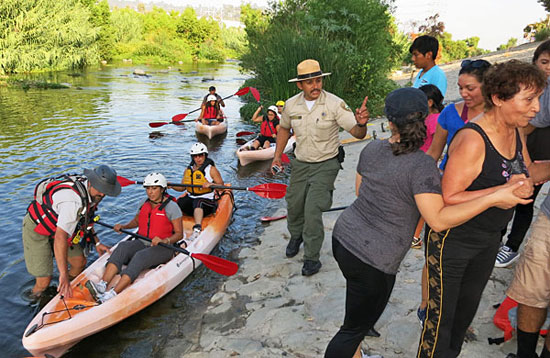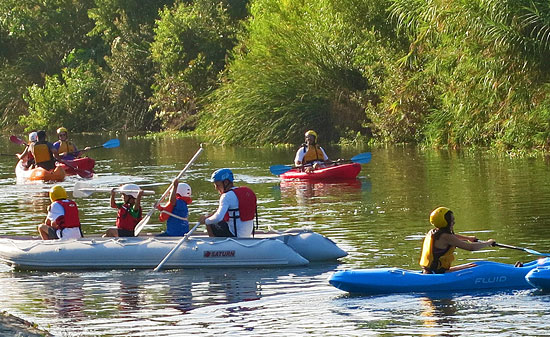Rising river lifts neighborhood, too
September 6, 2013

Chief Ranger Fernando Gomez orchestrates a "community paddle." Photos/Grove Pashley, LA River Kayak Safari
It was still weeks before kayakers would start journeying down a lush stretch of the Los Angeles River, but boosters of the summer-long pilot program could feel the resentment building.
Residents of Elysian Valley were worried that interlopers would start flocking to—and disrespecting—their diverse, working-class neighborhood along the river. Some wary families were still nursing hurts going back generations, when people were relocated to “Frogtown” after being forced from nearby Chavez Ravine to make way for the Brooklyn Dodgers’ new home.
“There are some long memories out there,” said artist Steven Appleton, chairman of the Elysian Valley Riverside Neighborhood Council and an advocate of the escalating efforts to remake the L.A. River. “A perception was developing that a lot of people from outside the area were going to take advantage of them.”
So Appleton donned another hat. He and his partner, Grove Pashley, quickly created a kayak company and began working with the Mountains Recreation and Conservation Authority to build a local constituency for the new Los Angeles River Recreation Zone—a brief, closely-watched collaboration that ended on Labor Day but is winning praise as a model of neighborhood engagement for the future.
News coverage of the pilot program has mostly focused on the strange yet appealing sight of 3,000-plus kayakers who, between Memorial Day and last Monday, worked their way down a 2.5-mile section of the river in the Glendale Narrows area. There, the bottom is coated in silt and rocks, unlike other sections of the 51-mile route, where concrete is the dominant feature. Paddlers included everyone from Los Angeles Mayor Eric Garcetti and County Supervisor Zev Yaroslavsky to veteran thrill seekers and upstart adventurers.
But what’s proven especially gratifying to organizers is the less heralded success of their strategy to get buy-in from Elysian Valley residents.
“We told them, ‘We want you to feel comfortable. We’re not excluding you. We’re including you. ’ It was my job to make sure they felt comfortable and welcomed,” said MRCA Chief Ranger Fernando Gomez.
Among other things, Gomez said, the MRCA, which managed the project on behalf of the City of Los Angeles, increased the number of rangers in the area and told them to enforce such park rules as no overnight camping, drinking or smoking. This quickly gave residents a heightened sense of security in a neighborhood with an engrained gang history. At night, Gomez said, he saw entire families—including a pregnant mom, her husband, son and family dog—walking along the riverbank’s bike path.
“That’s something I never would have seen 10 or 15 years ago. Back then, if people were out, they were up to no good,” said Gomez, who patrolled the area as a rookie ranger. “These families have stepped up and said: ‘This is our backyard.’ ”
Another turning point came when Appleton’s company started to organize “community paddle” evenings for locals, many of whom couldn’t afford the kayak tours ranging in price from $55 to $65, offered by Appleton and a competing company. In all, there were three events, which took place between 4 p.m. and 7 p.m. The final one drew a crowd of 70 residents.
Appleton said one of his best memories of those evenings was of a woman who’d lived along the river her entire life but had never ventured into the water, not even as a kid. “It was on her bucket list,” Appleton said. Although she tumbled five times into the calm and shallow waters in front of Marsh Park, she was having such a good time that, unlike other residents, she wouldn’t relinquish her boat.
“It was occupied the entire three hours,” Appleton recalled admiringly. “She just wouldn’t get out.”
“Initially people in the community were skeptical” of the recreation zone, said Appleton, who began canoeing as a youngster in Michigan. “But those events really helped turn things around.”
Ranger Gomez was more effusive: “The community was ecstatic about it.”
Come next summer, river advocates hope the Glendale Narrows recreation zone will be back and embraced by the community—along with some changes for the next wave of kayakers.
Among other things, Gomez said, it would be helpful to have a second exit along the 2.5 mile zone so novice kayakers, weary from paddling or navigating rocks, can get out sooner. What’s more, he said he’d recommend removing some rocks in difficult passages to create “a little alley or lane that doesn’t alter the river in any shape or form” so frustrated kayakers don’t have to work so hard. “For a quarter of a mile, I don’t think the world would end downstream.”
Like Appleton, the ranger of 20 years has a memory that he also says he’ll treasure of the recreation zone’s inaugural season. His is of a young boy, around 12, who works as a “junior ranger” and is always quiet— “just a follower,” in the words of one MRCA colleague.
The youngster was the last down to the water. When he got into the boat, Gomez said, “he clenched his teeth and was literally started shaking with fear. I said, ‘Hi Buddy. I’m going to help you out. I’m going to teach you how to paddle—right, left, right, left. Not only did he learn about the river, he learned the skill of kayaking. By the end of the trip, he was racing other kids.”
Gomez paused at the memory. “I’m getting chills thinking about it,” he said.

Elysian Valley activist and entrepreneur Steven Appleton takes some neighborhood youngsters for a paddle.
Posted 9/6/13












 405 bridge work causes a stink
405 bridge work causes a stink
